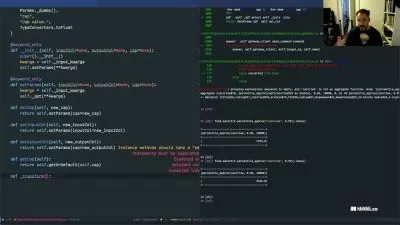Problem Solving using PySpark - Regression & Classification
Sathish Jayaraman
1:48:52
Description
Gradient Boosted Trees, XGBoost, Spark NLP, Time Series, Prophet, Data Cleaning, Descriptive Statistics, Spark SQL
What You'll Learn?
- Data analysis and descriptive statistics with PySpark - Learning to compute essential descriptive statistics for data understanding and summarization
- Data Cleaning with PySpark
- Predictive modeling with PySpark using Regression
- Applying Classification techniques to a real world problem in PySpark
- Text analytics using PySpark and Spark NLP
- Time-Series modeling with PySpark and Prophet
- Introduction to Spark SQL for data querying
Who is this for?
What You Need to Know?
More details
DescriptionThis course is based on real world problems in PySpark, surrounding Data Cleaning, Descriptive statistics, Classification and Regression Modeling.
The first segment introduces descriptive statistics in PySpark and computing fundamental measures such as mean, standard deviation and generating an extended statistical summary.
The second segment is based on cleaning the data in PySpark, working with null values, redundant data and imputing the null values.
The third segment is about Predictive modeling with PySpark using Gradient Boosted Trees Regression
The fourth and fifth segments are based on applying classification techniques in PySpark. The fourth Segment introduces the application of Spark XGB Classifier for a classification problem and the fifth segment is about using a deep learning model for text sentiment classification.
The sixth segment is about time series analytics and modeling using PySpark and Prophet
The seventh segment introduces Spark SQL for data querying and analysis.
These segments also include advanced visualization techniques through Seaborn and Plotly libraries including Box plots to understand the distribution of the data and assessment of outliers, Count plots to understand balance in the proportion of data, Bar chart to represent feature importance as part of the Gradient Boosted Trees Regression Model, Word Cloud for text analytics and analyzing time series data to extract seasonality and trend components.
Each of these segments, has a Google Colab notebook included aligning with the lecture.
Who this course is for:
- This course is suited for anyone interested in the realm of analytics using PySpark - particularly useful for analysts and engineers interested in Big Data, someone with a basic knowledge of data science and ML principles
This course is based on real world problems in PySpark, surrounding Data Cleaning, Descriptive statistics, Classification and Regression Modeling.
The first segment introduces descriptive statistics in PySpark and computing fundamental measures such as mean, standard deviation and generating an extended statistical summary.
The second segment is based on cleaning the data in PySpark, working with null values, redundant data and imputing the null values.
The third segment is about Predictive modeling with PySpark using Gradient Boosted Trees Regression
The fourth and fifth segments are based on applying classification techniques in PySpark. The fourth Segment introduces the application of Spark XGB Classifier for a classification problem and the fifth segment is about using a deep learning model for text sentiment classification.
The sixth segment is about time series analytics and modeling using PySpark and Prophet
The seventh segment introduces Spark SQL for data querying and analysis.
These segments also include advanced visualization techniques through Seaborn and Plotly libraries including Box plots to understand the distribution of the data and assessment of outliers, Count plots to understand balance in the proportion of data, Bar chart to represent feature importance as part of the Gradient Boosted Trees Regression Model, Word Cloud for text analytics and analyzing time series data to extract seasonality and trend components.
Each of these segments, has a Google Colab notebook included aligning with the lecture.
Who this course is for:
- This course is suited for anyone interested in the realm of analytics using PySpark - particularly useful for analysts and engineers interested in Big Data, someone with a basic knowledge of data science and ML principles
User Reviews
Rating
Sathish Jayaraman
Instructor's Courses
Udemy
View courses Udemy- language english
- Training sessions 34
- duration 1:48:52
- Release Date 2024/03/12










